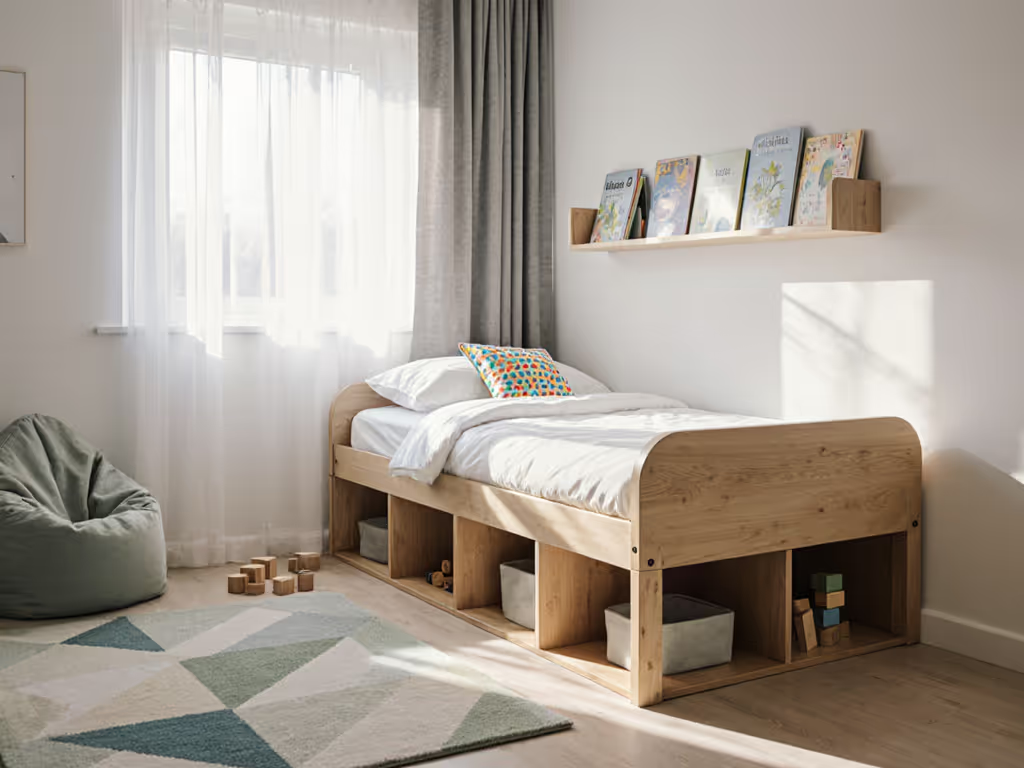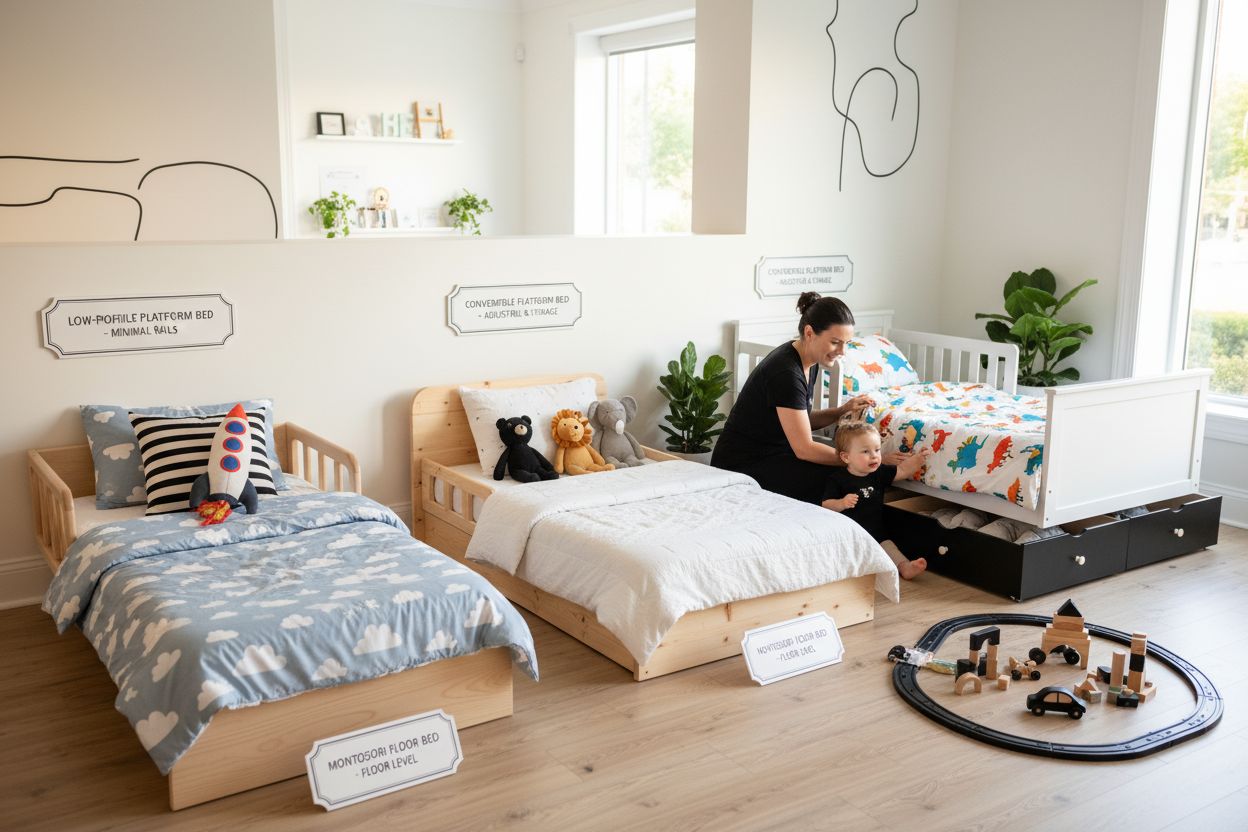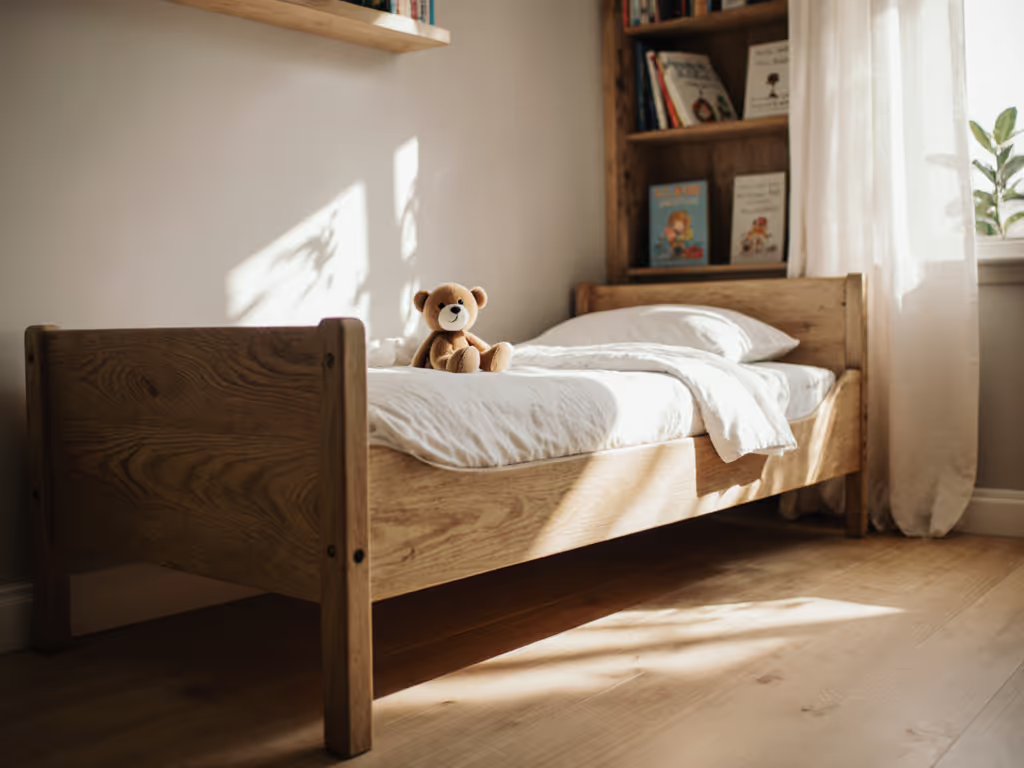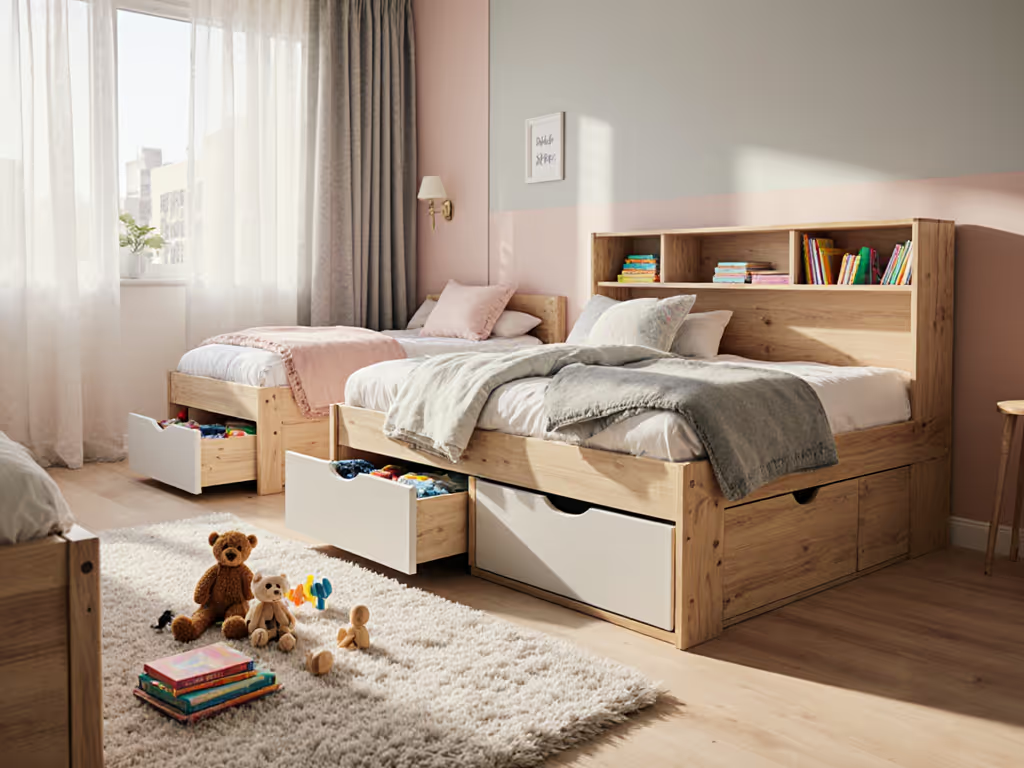
Platform Beds for Toddlers: Complete Parental Guide

Did you know that toddlers make over one thousand attempts to leave their bed each year as they gain independence? As children grow out of cribs, choosing the right sleeping setup becomes a decision that impacts safety, comfort, and development. Platform beds for toddlers are designed with these unique needs in mind, making sleep both safer and more accessible as your little one becomes increasingly curious and mobile.
Key Takeaways
| Point | Details |
|---|---|
| Developmental Transition | Platform beds facilitate the transition from crib to toddler bed, providing a safe environment for growing independence. |
| Safety Features | Their low-profile design reduces fall risks and encourages self-directed movement in toddlers. |
| Space Efficiency | These beds are designed to save space while incorporating multifunctional storage solutions, ideal for compact living areas. |
| Versatile Designs | Options like convertible and Montessori-inspired beds allow customization to meet individual child needs and preferences. |
Defining Platform Beds for Toddlers
A platform bed represents a pivotal milestone in your toddler's sleep journey, bridging the gap between confined infant cribs and more expansive childhood sleeping spaces. Unlike traditional raised beds with complex frame structures, platform beds offer a low-profile, minimalist design that sits directly on the floor or uses a simple, sturdy base. This design isn't just about aesthetics - it's fundamentally about creating a safe, accessible sleeping environment for curious and increasingly mobile young children.
Typically designed for children transitioning out of cribs (usually between 18 months to 3 years), platform beds provide several critical advantages. Their near-ground positioning means minimal fall risks, allowing toddlers to independently enter and exit their sleeping space. The simplicity of design translates into practical benefits: easier bed-making, straightforward cleaning, and a seamless integration into compact living spaces. Parents often appreciate how these beds grow with their child, offering a versatile solution that adapts to changing developmental stages.
Key characteristics that define a toddler platform bed include:
- Low height (typically 6-12 inches from the ground)
- Minimal side rails or protective edges
- Sturdy, flat base supporting the mattress
- Space-efficient design
- Lightweight materials for easy repositioning
While seemingly simple, these beds represent a thoughtful approach to childhood sleep spaces. They acknowledge that toddlers are no longer infants needing complete containment but aren't yet ready for standard adult-sized beds. Platform beds strike a perfect balance - offering safety, independence, and a sense of growing autonomy that supports your child's emerging mobility and confidence.
Major Types and Key Variations Explained
Toddler platform beds have evolved far beyond simple sleeping surfaces, offering parents a range of design options that cater to different developmental needs, spatial constraints, and individual child preferences. Standard platform beds represent the most traditional approach - featuring a low-profile design with minimal side protection, typically ranging between 20-35 cm in height. These beds provide an open, unrestricted environment that encourages independence while maintaining basic safety parameters.
Montessori-inspired floor beds offer a radical departure from conventional sleeping arrangements. Positioned just 5-10 cm from the ground, these beds embody a philosophy of child autonomy and exploration. Without restrictive railings, they allow toddlers to freely enter and exit their sleeping space, promoting motor skill development and fostering a sense of self-directed movement. Parents seeking a minimalist, developmental approach often gravitate towards these designs, appreciating their potential to support early childhood learning and physical confidence.
The most versatile category includes convertible platform beds with innovative features:
- Extendable frame designs that grow with the child
- Optional removable side rails for transitional safety
- Integrated storage compartments
- Modular configurations adaptable to room layouts
- Sensory-friendly designs with soft edges and comfortable materials
Specialty variations like canopy or sensory-enhanced platform beds provide additional dimensions of comfort and security. These designs incorporate enclosed spaces, soft fabric draping, or textured materials that create a cozy, protected sleeping environment. Such beds can be particularly beneficial for children who experience sensory processing challenges or simply enjoy a more contained, nurturing sleep space. The key is matching the bed type to your toddler's unique personality and developmental stage.

Here's how the main types of toddler platform beds compare:
| Bed Type | Height from Floor | Safety Features | Best For |
|---|---|---|---|
| Standard Platform | 20-35 cm | Minimal side rails<br>Sturdy base | Everyday use<br>General needs |
| Montessori Floor | 5-10 cm | No rails<br>Flat design | Maximum independence<br>Early exploration |
| Convertible Platform | 6-35 cm (adjustable) | Removable rails<br>Storage options | Growing with child<br>Long-term use |
| Canopy/Sensory | 10-20 cm | Enclosures<br>Soft edges | Sensory comfort<br>Extra security |
Core Benefits for Toddler Sleep and Safety
Platform beds represent more than just a sleeping surface - they're a strategic solution designed to support your toddler's critical developmental transitions. Physical safety emerges as the primary advantage, with low-profile designs dramatically reducing fall risks compared to traditional raised beds. By positioning the sleeping area close to the ground, these beds create an inherently protective environment that allows curious toddlers to explore their independence without compromising their physical security.
Beyond physical protection, platform beds significantly contribute to a toddler's emotional and developmental well-being. The accessible design encourages self-directed movement, helping children develop motor skills and spatial awareness. When toddlers can independently enter and exit their sleeping space, they experience a sense of autonomy that boosts confidence and supports early learning. This approach aligns closely with developmental psychology principles that emphasize creating environments which allow children to safely explore and understand their surroundings.
Key safety benefits of platform beds include:
- Minimal height (5-10 cm) reducing potential injury from falls
- Smooth, rounded edges preventing accidental bumps
- Non-toxic, child-safe materials
- Stable base preventing unintended sliding or tipping
- Open design promoting visual and physical accessibility
Psychologically, these beds create a sense of security while simultaneously promoting independence. The controlled environment helps toddlers feel protected, yet not confined, striking a delicate balance between safety and exploration. By choosing a platform bed, parents invest in a sleep solution that supports physical safety, emotional development, and the natural progression of childhood learning.
Space-Saving and Storage Features Analyzed
In today's compact living environments, platform beds emerge as a game-changing solution for parents navigating limited bedroom spaces. Their low-profile, minimalist design inherently contributes to spatial efficiency, eliminating the bulky frameworks typical of traditional toddler beds. By sitting directly on the floor or using a slim base, these beds create an illusion of openness, making even the smallest rooms feel more expansive and adaptable to a growing child's needs.
Modern platform beds go beyond simple space conservation, integrating smart storage solutions that transform sleeping areas into multifunctional spaces. Innovative designs now incorporate built-in drawers, under-bed compartments, and modular configurations that maximize every square inch of available room. These features are particularly valuable for families living in apartments, shared bedrooms, or homes with limited square footage. Parents can strategically use these integrated storage spaces for storing seasonal clothing, extra bedding, toys, or other toddler essentials, keeping the room organized and clutter-free.
Key space-saving and storage features include:
- Integrated pull-out drawers beneath the sleeping surface
- Modular design allowing reconfiguration as room layouts change
- Slim, compact frames that occupy minimal floor space
- Lightweight materials enabling easy repositioning
- Optional side shelving for books, nighttime essentials
Beyond physical storage, these beds offer psychological benefits of organization and simplicity. By creating a streamlined, uncluttered sleeping environment, platform beds help reduce visual noise and create a calming space that supports restful sleep. The ability to customize and adapt the bed's configuration means parents can evolve the sleeping area as their toddler grows, ensuring long-term functionality and value.
Comparing Platform Beds to Other Options
Navigating the transition from infant cribs to toddler beds requires understanding the nuanced differences between various sleeping solutions. Traditional cribs, typically used for children up to two years old, provide high-walled containment that restricts movement but ensures maximum safety. In contrast, platform beds represent a more dynamic approach, offering a low-profile design that balances safety with a child's growing need for independence and mobility.
When comparing bed types, Montessori-inspired floor beds and platform beds share similar philosophies of child autonomy. Both designs position the sleeping surface close to the ground, minimizing fall risks and encouraging self-directed exploration. However, platform beds often provide more versatility with optional safety features like removable rails, making them a more adaptable choice for parents seeking a middle ground between complete containment and total freedom.
Key comparative features across toddler bed types:
- Cribs: High walls, maximum containment, limited mobility
- Traditional toddler beds: Slightly raised, partial railings, transitional design
- Montessori floor beds: Ground-level, no rails, maximum independence
- Platform beds: Low-profile, optional safety features, modular design
- Convertible beds: Adjustable sizing, potential long-term use
Ultimately, the choice depends on individual family needs, room configurations, and a child's developmental stage. Platform beds emerge as a compelling option, offering a perfect blend of safety, design flexibility, and support for a toddler's emerging sense of autonomy.
![]() They acknowledge that children are not just small beings to be contained, but active learners ready to explore their environment with increasing confidence.
They acknowledge that children are not just small beings to be contained, but active learners ready to explore their environment with increasing confidence.
Find Safe, Space-Saving Solutions for Your Toddler’s Sleep Needs
When choosing a toddler platform bed, it can feel overwhelming to balance safety, space, and your child’s need for independence. As highlighted above, parents often worry about fall risks, outgrowing beds too quickly, or fitting the right sleeping solution into a small or shared space. If you’re searching for expert-led guides about platform beds, conversion options, and storage features, you’re not alone. Our comprehensive resources address these exact concerns, helping you move forward with confidence.
If you want clear advice about toddler bed safety, space optimization, and choosing the best designs for your little one’s transition out of the crib, explore the full range of expert articles and practical solutions at https://citytoddlerbeds.store. Deepen your understanding with in-depth reviews and tips for making your toddler’s room safer and more functional. Discover more actionable guidance and take the next step toward a smoother sleep transition by visiting our latest guides. Start now and feel empowered to make the right choice for your family’s unique sleep space.
Frequently Asked Questions
What are the main benefits of using a platform bed for toddlers?
Platform beds provide a low-profile sleeping solution that enhances safety by minimizing fall risks. They encourage independence, allowing toddlers to easily enter and exit their sleeping space, which supports motor skills and emotional development.
How do toddler platform beds differ from traditional toddler beds?
Toddler platform beds feature a lower height and often have minimal to no side rails, promoting autonomy and easy access. In contrast, traditional toddler beds typically have raised frames and partial railings for added containment, which may limit a child's movement.
What is a Montessori-inspired floor bed, and how does it benefit toddlers?
A Montessori-inspired floor bed is positioned very close to the ground (5-10 cm) and lacks side rails. This design supports maximum independence, allowing toddlers to explore their sleeping space freely and develop self-directed movement skills, which aligns with their developmental needs.
Can platform beds provide storage solutions for small spaces?
Yes, many modern platform beds come with integrated storage features like under-bed drawers and modular designs. These options maximize space efficiency, making them ideal for compact living environments while helping to keep the toddler's room organized.




